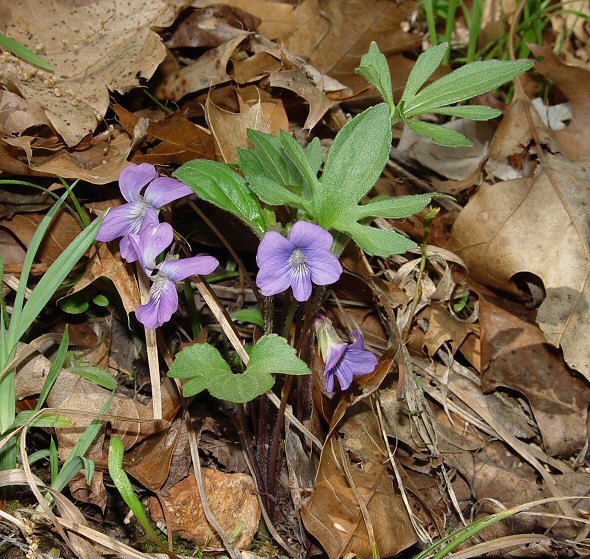Viola palmata L.
Cleft Violet

Native
CC = 5
CW = 3
MOC = 64
© DETenaglia
Viola palmata L.Cleft Violet | |
 |
Native CC = 5 CW = 3 MOC = 64 |
© DETenaglia |
|
Family - Violaceae Habit - Perennial forb to 30 cm tall, with fleshy roots and a short, prostrate to sometimes ascending rhizome 4-6 mm thick. Stems - Aerial stems absent.
Leaves - All basal, long-petiolate, the petiole finely hairy. Stipules conspicuous, membranous to somewhat herbaceous, free from the petiole, narrowly lanceolate, the margins usually entire, glandular-hairy. Leaf blades 1.5-9.5 cm long, about as long to about 2 times as long as wide, variously ovate to kidney-shaped, heart-shaped, or triangular-ovate, those produced early and late in the season unlobed, the main season leaves shallowly to deeply lobed, often somewhat irregularly so, the segments not lobed again, at least the central one lanceolate to triangular-ovate and mostly more than 3 mm wide, the margins otherwise entire or toothed toward the segment tips (sometimes also minutely hairy), the surfaces moderately pubescent with fine, spreading or shaggy hairs.
Inflorescences - Flower borne singly on long peduncles arising from caudex, not or only slightly overtopping the leaves. Peduncles glabrous, to 12 cm long, hooked at apex. Flowers - Sepals 5, 3-9 mm long, oblong-lanceolate, rounded or broadly angled to a bluntly pointed tip, the margins minutely hairy, the basal auricles short and inconspicuous. Corollas 9-20 mm long, the 5 petals oriented more or less forward in life but curved or arched outward or backward toward their tips, longer than the sepals, bluish purple (with a greenish white throat and usually darker veins), the lateral petals bearded on the upper surface with slender hairs, the lower petal glabrous, the spur conspicuous, well-exserted beyond the sepal auricles, stout and often somewhat hemispheric in shape. All petals glabrous externally. Stamens 5, not exserted, typically not visible without dissection of the flower. Style slender, slightly expanded into a narrow, more or less scoop-shaped, hollow, truncate tip. Ovary superior, green, glabrous, 3 mm long, unilocular, somewhat conic. Ovules numerous. Cleistogamous flowers frequently dark green mottled with purple.
Fruits - Capsules 8-10 mm long, broadly ellipsoid to broadly ovoid, green to olive green, often tinged or mottled with purple, the surface glabrous. Seeds 1.7-2.0 mm long, brown to tan or orangish yellow, sometimes mottled.
Flowering - April - May. Habitat - Mesic upland forests, bluffs, and streambanks, railroads, roadsides. Origin - Native to the U.S. Lookalikes - When very young, plants resemble other violets such as V. sororia. Main season plants with lobed leaves are distinctive. Other info. - This is one of the more common violets, found across most of Missouri but less common or absent in the northwestern third of the state. It occurs across most of the eastern continental U.S. and also ranges into Canada. It is one of the easier violets to identify, at least during the main season, when the leaves are palmately lobed. Young plant having only unlobed leaves can be hard to distinguish from the very common V. sororia. The plant seems to have a slight preference for acidic soils. The species has been subdivided on the basis of leaf lobe morphology, but extensive intergradation makes infraspecific assignment difficult in many cases. Photographs taken at Rock Bridge State Park, Columbia, MO., 4-17-04 (DETenaglia); also at Engelmann Woods Natural Area, Franklin County, MO, 4-28-2015, and Glassberg Conservation Area, Jefferson County, MO, 4-30-2020 (SRTurner). |